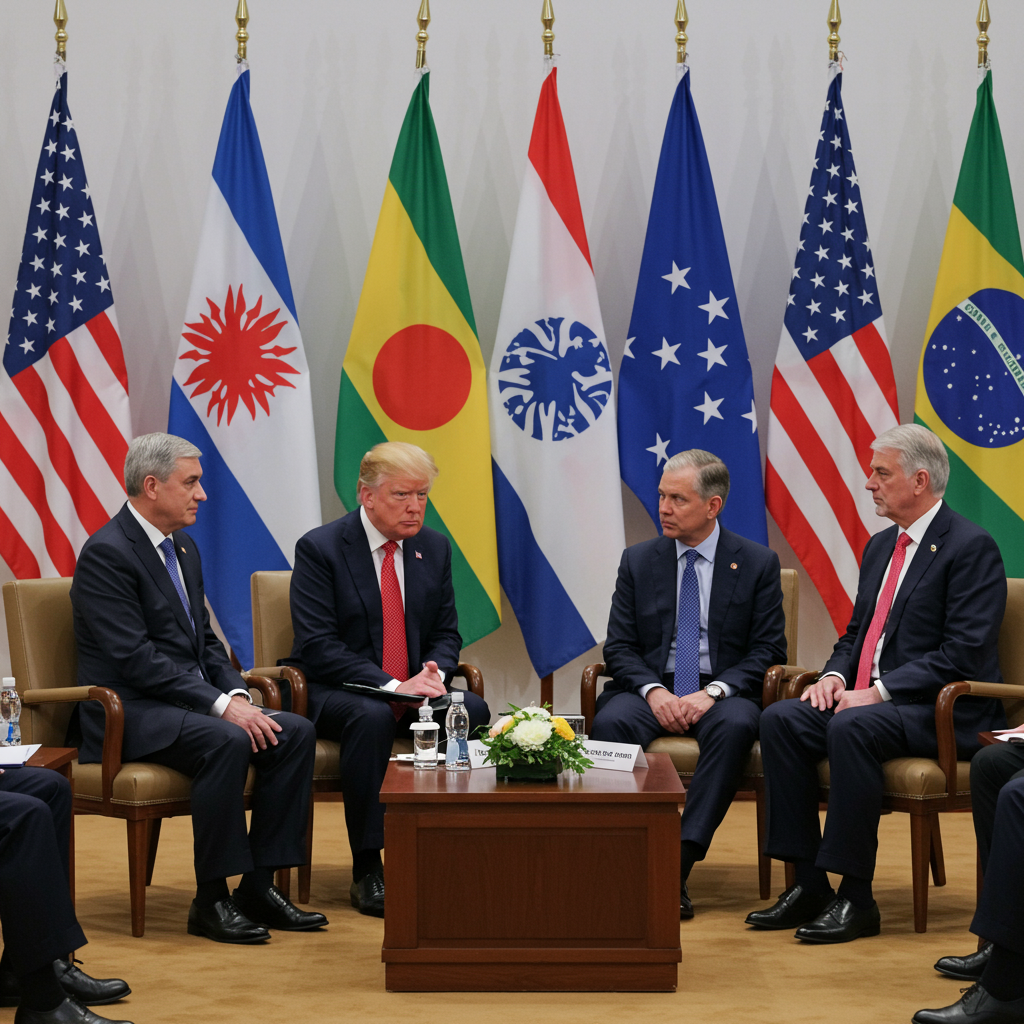Leading emerging economies, united under the brics banner, convened in Rio de Janeiro with a clear message: unilateral trade tariffs pose a significant threat to global economic stability. Sources close to the July 2025 summit discussions indicated a strong consensus among member nations to voice sharp criticism regarding the protectionist trade policies advanced by former U.S. President Donald Trump. This anticipated condemnation, though carefully worded to avoid directly naming the United States or its leader, was seen as a deliberate political signal directed squarely at Washington.
The gathering of nations representing nearly half the world’s population and a substantial portion of its economic output aimed to present a united front against what they perceive as unfair import taxes. The context included recent actions by Mr. Trump, who had reportedly informed trading partners of new tariff rates expected imminently, around July 9, 2025.
BRICS Nations Unite Against Unilateral Trade Measures
Diplomats from the eleven member states, which now include Brazil, Russia, India, China, South Africa, Egypt, Ethiopia, Iran, Indonesia, and the United Arab Emirates, dedicated efforts to drafting a joint statement. This declaration was designed to express serious concern over the use of unilateral tariff and non-tariff measures, specifically condemning “unilateral coercive measures that are contrary to international law.”
While the final communiqué was anticipated to adopt a cautious tone, steering clear of explicit references to the U.S., experts noted the intent was unmistakable. Marta Fernandez, director of the BRICS Policy Center at Rio’s Pontifical Catholic University, highlighted the sensitivity, particularly for China, which had recently engaged in trade negotiations with the U.S. to lower existing levies. Provoking further friction at this juncture did not appear strategically beneficial for Beijing.
Navigating Internal Divisions and Global Crises
Despite a shared perspective on challenging Western power dynamics, particularly U.S. trade policy, the summit also underscored existing fault lines within the expanded BRICS bloc. Divisions were particularly apparent regarding responses to complex global crises, notably the ongoing conflicts in the Middle East.
Iranian negotiators, for instance, were reportedly advocating for a significantly tougher collective stance on the situation in Gaza and the Iran-Israel tensions than some other members were willing to adopt. Discussions revolved around condemning the use of starvation as a warfare method, calling for Israeli troop withdrawal from Gaza, and opposing the forced displacement of Palestinians. Reaching a consensus on such sensitive geopolitical issues proved challenging, potentially diluting the group’s ability to “speak with one voice,” as Brazil’s Foreign Minister Mauro Vieira hoped.
Adding to the summit’s complex dynamic was the notable absence of key leaders. Chinese President Xi Jinping skipped the annual meeting for the first time in over a decade, delegating attendance to Premier Li Qiang. Analysts like Ryan Hass from the Brookings Institution speculated reasons ranging from having recently hosted Brazilian President Lula da Silva in Beijing to potentially avoiding being overshadowed by Indian Prime Minister Narendra Modi, who was a guest of honor. Russian President Vladimir Putin, facing international indictment, also chose to participate via video link rather than attend in person. Iran’s President Masoud Pezeshkian was another significant absentee amidst regional conflict. These absences were viewed as a setback for host President Lula da Silva’s aspirations to elevate Brazil’s global standing.
Beyond Trade: Addressing AI, Health, and Climate
While challenging perceived U.S. protectionism was a central theme, the BRICS agenda extended to other critical global issues where their positions often contrast with the Trump administration’s stance. Artificial intelligence and health were formally on the summit’s agenda.
Sources familiar with the draft statement indicated that BRICS leaders planned to reaffirm support for the Paris climate agreement, a global accord the U.S. had withdrawn from. They also aimed to advocate for international governance mechanisms concerning artificial intelligence to mitigate potential risks – a position differing from the U.S. approach, which has generally favored less regulation in this leading technological field.
The Expanding Influence and New Fault Lines
The recent expansion of BRICS to include Saudi Arabia, Iran, the UAE, Egypt, Ethiopia, and Indonesia alongside the original five members (Brazil, Russia, India, China, South Africa) has significantly boosted the group’s demographic and economic weight, potentially giving it more international leverage. The summit was also expected to welcome additional “partner countries,” signaling further aspirations for broader influence.
However, this rapid expansion has simultaneously introduced new points of divergence and complexity. Balancing the diverse national interests and geopolitical positions of eleven distinct nations, some with historical rivalries or different relationships with major global powers, makes forging truly unified stances on every issue a difficult endeavor. The disagreements over the Middle East conflict served as a prime example of these emerging fault lines.
Brazil, as the host nation, expressed hope that the group could find common ground on even the most sensitive subjects, drawing on the historical instances where BRICS nations have managed to align their views on major international affairs. However, the varying levels of closeness to Washington among members, particularly India, further complicated the effort to issue a collective, strongly worded rebuke of U.S. policies without risking internal friction.
Frequently Asked Questions
Why did BRICS nations plan to condemn Trump’s trade tariffs?
BRICS countries planned to criticize former U.S. President Donald Trump’s tariffs primarily because they viewed them as unilateral protectionist measures that violated international law and created global economic uncertainty. As emerging economies heavily reliant on international trade, member nations felt negatively impacted by sudden tariff impositions and threats against trading partners, seeing them as unfair and harmful to their economic interests. The planned statement specifically targeted “unilateral coercive measures.”
What other major issues were on the agenda at the BRICS summit in Rio besides tariffs?
In addition to trade tariffs, the BRICS summit agenda in Rio de Janeiro included discussions on several other critical global topics. Leaders planned to address the complex conflicts in the Middle East, particularly the situations in Gaza and between Iran and Israel, though finding a unified stance proved challenging. Artificial intelligence governance and global health initiatives were also listed as key discussion points for the multilateral forum.
Who were the key leaders absent from the BRICS summit, and why did their absence matter?
Several prominent leaders were absent from the Rio BRICS summit. Chinese President Xi Jinping missed the meeting for the first time in his presidency, with reasons speculated to range from prior engagements to avoiding being overshadowed by other attendees. Russian President Vladimir Putin participated via video link due to international circumstances. Iran’s President Masoud Pezeshkian also did not attend amidst regional conflict. Their absences were seen as diminishing the political weight and visibility of the summit, particularly impacting host President Lula da Silva’s efforts to showcase Brazil’s international role.
A Collective Signal to Washington
Ultimately, the BRICS summit in Rio de Janeiro was poised to deliver a collective signal to the United States regarding its trade practices. While navigating internal complexities and the absence of key figures, the core message condemning unilateral tariffs was expected to be clear. The gathering highlighted the group’s growing ambition to challenge established global norms and assert its perspective on issues ranging from trade and conflict to technology and climate, albeit with the inherent challenges of aligning the diverse interests of its expanding membership. The delicate balance between expressing dissent and maintaining stable relations, particularly with major trading partners like the U.S., remained a central theme for the bloc’s diplomatic efforts.



